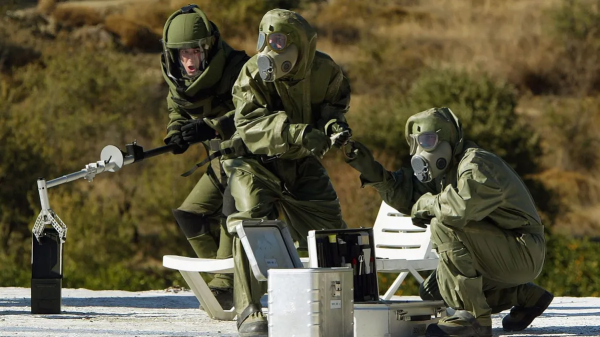Researchers claim that viral accumulation in the lungs is the probable cause of the COVID-19 pandemic’s high death rates.
COVID-19 patients who died had 10 times the number of viruses in their lower airways. Meanwhile, extremely sick patients survived their disease. This was according to researchers from New York University’s Grossman School of Medicine in the United States.
The discovery, published in the journal Nature Microbiology, debunks prior ideas that several infections related to COVID-19 had a significant role in increased mortality risk.

LANDOVER, MARYLAND – MARCH 30: Healthcare professionals prepare to screen people for the coronavirus at a testing site erected by the Maryland National Guard in a parking lot. (Photo by Chip Somodevilla/Getty Images)
Antibiotics Causing COVID-19 Deaths?
The researchers found no indication that the fatalities were caused by a secondary bacterial infection. They warned that this may be related to the frequent use of antibiotics in critically sick patients.
The researchers pointed out that existing CDC recommendations do not recommend the use of antivirals like ivermectin for critically sick patients on mechanical ventilation. According to experts, these medicines may still be useful in treating patients.
Despite earlier worries that the virus could cause the immune system to attack the body’s own lung tissue, resulting in hazardous levels of inflammation, the researchers found no indication that this was a significant factor in COVID-19 fatalities in the study group.
The intensity of the immune reaction seemed to be proportional to the numbers of viruses in the lungs, U.S. News said, citing the researchers. Over 4 million individuals have died as a result of the coronavirus. Those who are dependent on mechanical ventilators to breathe do especially badly.
High Bacterial Load Caused Death In Previous Pandemics
Experts believe that a subsequent bacterial infection caused the significant mortality observed in previous viral pandemics. Examples are the Spanish flu in 1918 and the swine flu in 2009. It was unclear if COVID-19 patients had a comparable problem.
According to the researchers, the new study is the most comprehensive examination of the lower airway environment in coronavirus patients. They took bacterial and fungal samples from the lungs of 589 men and women in the United States. The participants were all on mechanical ventilation.
The researchers examined the quantity of virus in the lower airways of 142 patients who also had a bronchoscopy operation to clear their airways. Afterward, they identified the bacteria by analyzing tiny bits of the germs’ genetic code.
Meanwhile, they also looked at the different kinds of immune cells and chemicals in the lower airways. In comparison to COVID-19 patients who survived the disease, those who died produced 50% less of a kind of immune molecule that targets the coronavirus.
These customized proteins are part of the body’s adaptive immune system. These are a group of cells and molecules that “remember” invading microorganisms and prepare the body for future encounters.
Study senior author Leopoldo Segal said in a statement that a flaw in the adaptive immune system is preventing the coronavirus from being successfully combated. If scientists can pinpoint the root of the problem, Segal believes they will be able to develop a therapy that works by strengthening the body’s natural defenses.
He emphasized that the researchers only looked at coronavirus patients who made it through the first two weeks of their stay in the hospital. According to Segal, bacterial infections or immunological responses might have a larger role in COVID-19 mortality that happens sooner.




![Tyson Foods Plant [Photo: Food Manufacturing]](https://southarkansassun.com/wp-content/uploads/2023/08/iStock_1185520857__1_.5e441daa51cca-600x337.jpg)








![Silverado Senior Living Management Inc. [Photo: Los Angeles Times]](https://southarkansassun.com/wp-content/uploads/2023/10/download-6-4-600x337.jpg)

![China's Wuhan Institute of Virology [Photo: Nature]](https://southarkansassun.com/wp-content/uploads/2023/09/d41586-021-01529-3_19239608-600x337.jpg)














